-
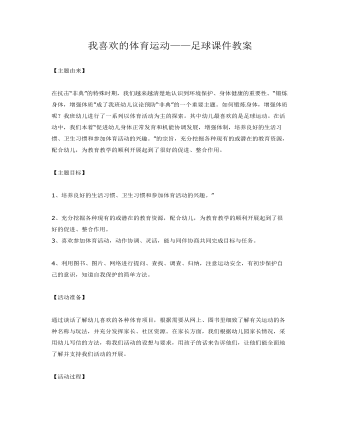
我喜欢的体育运动——足球课件教案
【主题目标】1、培养良好的生活习惯、卫生习惯和参加体育活动的兴趣。”2、充分挖掘各种现有的或潜在的教育资源,配合幼儿,为教育教学的顺利开展起到了很好的促进、整合作用。3、喜欢参加体育活动,动作协调、灵活,能与同伴协商共同完成目标与任务。4、利用图书、图片、网络进行提问、查找、调查、归纳,注意运动安全,有初步保护自己的意识,知道自我保护的简单方法。【活动准备】通过谈话了解幼儿喜欢的各种体育项目,根据需要从网上、图书里细致了解有关运动的各种名称与玩法,并充分发挥家长、社区资源。在家长方面,我们根据幼儿园家长情况,采用幼儿写信的方法,将我们活动的设想与要求,用孩子的话来告诉他们,让他们能全面地了解并支持我们活动的开展。【活动过程】1、教师通过谈话,了解幼儿最喜欢的体育运动。幼儿:我喜欢踢足球。幼儿:我喜欢跑步。
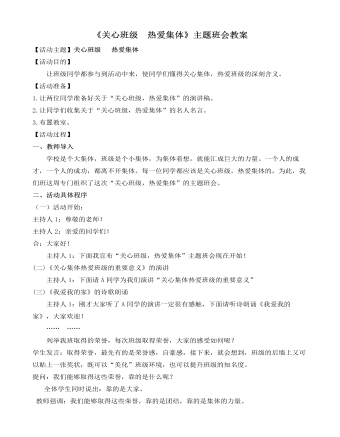
《关心班级 热爱集体》主题班会教案
【活动主题】关心班级 热爱集体【活动目的】让班级同学都参与到活动中来,使同学们懂得关心集体,热爱班级的深刻含义。【活动准备】 1.让两位同学准备好关于“关心班级,热爱集体”的演讲稿。2.让同学们收集关于“关心班级,热爱集体”的名人名言。3.布置教室。【活动过程】一、教师导入学校是个大集体,班级是个小集体,为集体着想,就能汇成巨大的力量。一个人的成才,一个人的成功,都离不开集体。每一位同学都应该是关心班级,热爱集体的。为此,我们班这周专门组织了这次“关心班级,热爱集体”的主题班会。二、活动具体程序(一)活动开始:主持人1:尊敬的老师!主持人2:亲爱的同学们!合:大家好!主持人1:下面我宣布“关心班级,热爱集体”主题班会现在开始!(二)《关心集体热爱班级的重要意义》的演讲主持人1:下面请A同学为我们演讲“关心集体热爱班级的重要意义”
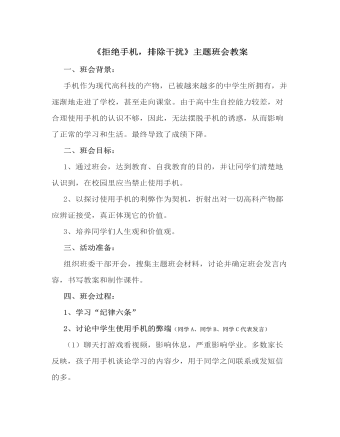
《拒绝手机,排除干扰》主题班会教案
一、班会背景:手机作为现代高科技的产物,已被越来越多的中学生所拥有,并逐渐地走进了学校,甚至走向课堂。由于高中生自控能力较差,对合理使用手机的认识不够,因此,无法摆脱手机的诱惑,从而影响了正常的学习和生活。最终导致了成绩下降。二、班会目标:1、通过班会,达到教育、自我教育的目的,并让同学们清楚地认识到,在校园里应当禁止使用手机。2、以探讨使用手机的利弊作为契机,折射出对一切高科产物都应辨证接受,真正体现它的价值。3、培养同学们人生观和价值观。三、活动准备:组织班委干部开会,搜集主题班会材料,讨论并确定班会发言内容,书写教案和制作课件。四、班会过程:1、学习“纪律六条”2、讨论中学生使用手机的弊端(同学A、同学B、同学C代表发言)(1)聊天打游戏看视频,影响休息,严重影响学业。多数家长反映,孩子用手机谈论学习的内容少,用于同学之间联系或发短信的多。
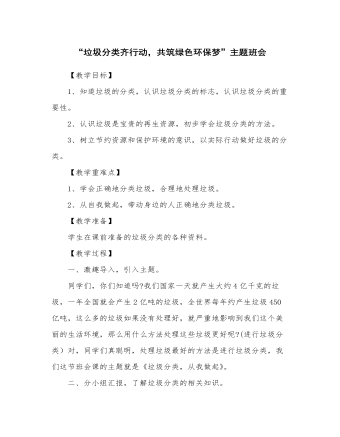
《垃圾分类齐行动,共筑绿色环保梦》主题班会教案
三、进行垃圾分类的知识问答竞赛。同学们,相信你们听了大家的介绍,对垃圾的知识已了解不少,下面进行垃圾分类的知识问答竞赛,比一比,看哪个同学记得牢。分两组题,第一组是必答题,每一小组必须答一道题目,组员可以补答。答对一道题五面小红旗,准备好了吗?第一题请第一组作答,我国城市一般把垃圾分成几类,它们分别是什么?(4类,可回收物、餐余垃圾、有害垃圾、其它垃圾)第二题:四种垃圾分别应该投放到什么颜色的垃圾桶。可回收物(蓝色)、有害垃圾(红色)、餐余垃圾(绿色)、其他垃圾(灰色)第三组:请列举2种餐余垃圾?(骨头、饭菜剩余物、瓜果皮等)第四组:请列举﹖种可回收物的名称。(废纸、玻璃、易拉罐等)第五组:请列举2种有害垃圾的名称。(有害垃圾:包括废电池、废日光灯管、废水银温度计、过期药品等)
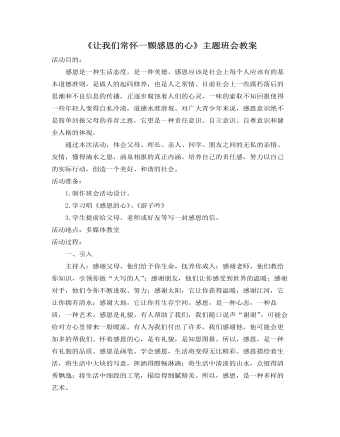
《让我们常怀一颗感恩的心》主题班会教案
一、引入 主持人:感谢父母,他们给予你生命,抚养你成人;感谢老师,他们教给你知识,引领你做“大写的人”;感谢朋友,他们让你感受到世界的温暖;感谢对手,他们令你不断进取、努力;感谢太阳,它让你获得温暖;感谢江河,它让你拥有清水;感谢大地,它让你有生存空间。感恩,是一种心态,一种品质,一种艺术。感恩是礼貌。有人帮助了我们,我们随口说声“谢谢”,可能会给对方心里带来一股暖流。有人为我们付出了许多,我们感谢他,他可能会更加多的帮我们。怀着感恩的心,是有礼貌,是知恩图报。所以,感恩,是一种有礼貌的品质。感恩是画笔。学会感恩,生活将变得无比精彩。感恩描绘着生活,将生活中大块的写意,挥洒得酣畅淋漓;将生活中清淡的山水,点缀得清秀飘逸;将生活中细致的工笔,描绘得细腻精美。所以,感恩,是一种多样的艺术。下面我宣布“让我们都有一颗感恩的心”主题班会现在开始!
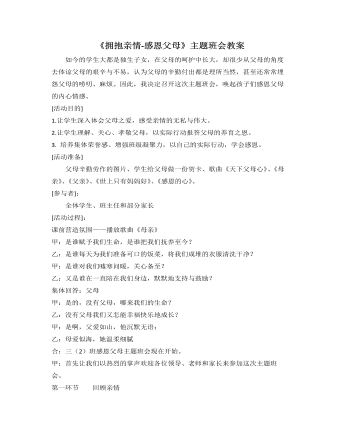
《拥抱亲情-感恩父母》主题班会教案
“正好啊,老树根是最适合坐下来休息的。来啊!孩子,坐下,快坐下来休息一下。”男孩坐了下来。树好快乐。她高兴得留下了流下了泪水……(故事结束后,课件出示父母辛苦劳作的图片,出示一组家庭生活图片,学生思考感悟。)请学生谈由图片和歌曲获得的感受和体会:“你想到了什么”?学生自由发言。甲:这就是我们的父母,他们无怨无悔,不求回报,真是可怜“天下父母心”啊!播放歌曲《天下父母心》:然而在日常生活中,我们总会与父母发生分歧甚至冲突顶撞,还常常埋怨父母的啰嗦。我们的母亲因为儿子的顽皮而无奈的哭泣;我们的父亲因为女儿的懒惰而叹气;请看小品:《丁丁在家里》(由部分学生和家长代表合演,主要凸显月休孩子在家不听父母教导,过于沉迷网络游戏,不写作业,不能按时作息而家长无可奈何的现象)。
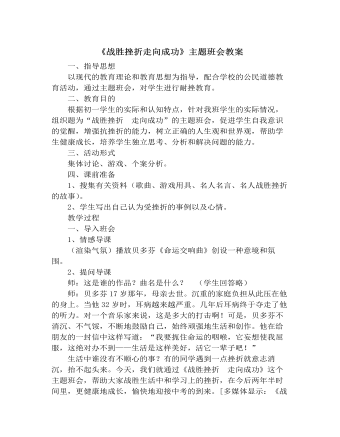
《战胜挫折 走向成功》主题班会教案
B、郑智化坐在轮椅上演唱自己作词作曲的歌《水手》。[多媒体播放郑智化唱《水手》一歌画面和音乐]①郑智化一上场为什么马上会赢得掌声?《水手》这首歌反映了郑智化怎样的思想境界?(引导学生谈郑智化的人生经历)由于郑智化的努力,“风雨中这点痛算什么”,经过思考斗争,使得悲观消极的情绪转化为奋斗有为、争取上进的积极情绪和心态。3、举出名人对待挫折的事例。(学生事先搜集,这里讲述梗概)司马迁在屈辱中完成了《史记》 屈原在流放期间写出《离骚》 曹雪芹在穷困潦倒中写出巨著《红楼梦》吴敬梓在贫困的寒夜写出了《儒林外史》……4、学生结合录相和故事,谈谈应该怎样正视挫折。[多媒体显示:怎样正视挫折]①要明白挫折是任何人都避免不了的,具有普遍、客观性。面对挫折时,要通过坚强的意志战胜自己的消沉和软弱,通过自己的努力,最终坚定地走向成功。[多媒体显示:挫折不可避免,通过坚强意志战胜]
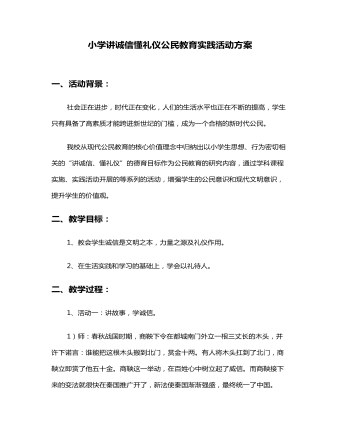
小学讲诚信懂礼仪公民教育实践活动教学教案
二、教学过程:1、活动一:讲故事,学诚信。1)师:春秋战国时期,商鞅下令在都城南门外立一根三丈长的木头,并许下诺言:谁能把这根木头搬到北门,赏金十两。有人将木头扛到了北门,商鞅立即赏了他五十金。商鞅这一举动,在百姓心中树立起了威信。而商鞅接下来的变法就很快在秦国推广开了,新法使秦国渐渐强盛,最终统一了中国。

教学反思数学仿编应用题活动《小鬼当家》课件教案
目的:1、让幼儿学会仿编和解答4的加减应用题。2、在生活情景中能根据水果卡片自编4的加减应用题。准备:1、知识经验准备:请家长带 幼儿去买东西,使幼儿了解一个买与卖的过程。2、物质准备:准备各种水果卡片,人手4个替代物作钱。过程:一、以“帮农民伯伯摘果子”引入。“小朋友,果园里的水果都成熟了,农民伯伯想请你们帮他摘水果,你们愿意吗?”(愿意)二、游戏“摘水果”。师交代游戏玩法和规则。三、分类活动:分水果。1、引导幼儿将自己所摘的水果跟同伴之间进行交流。2、交代任务:将各种水果分别放在筐里。
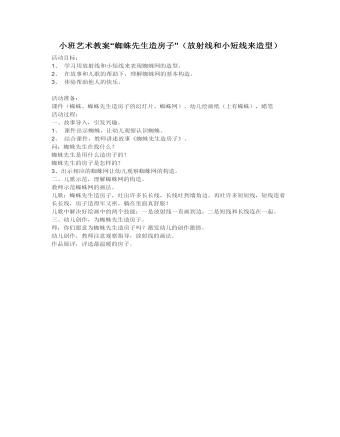
小班艺术教案“蜘蛛先生造房子”(放射线和小短线来造型
2、 在故事和儿歌的帮助下,理解蜘蛛网的基本构造。 3、 体验帮助他人的快乐。 活动准备: 课件(蜘蛛、蜘蛛先生造房子的幻灯片、蜘蛛网)、幼儿绘画纸(上有蜘蛛),蜡笔 活动过程: 一、故事导入,引发兴趣。 1、 课件出示蜘蛛,让幼儿观察认识蜘蛛。 2、 结合课件,教师讲述故事《蜘蛛先生造房子》。 问:蜘蛛先生在找什么? 蜘蛛先生是用什么造房子的? 蜘蛛先生的房子是怎样的? 3、出示相应的蜘蛛网让幼儿观察蜘蛛网的构造。
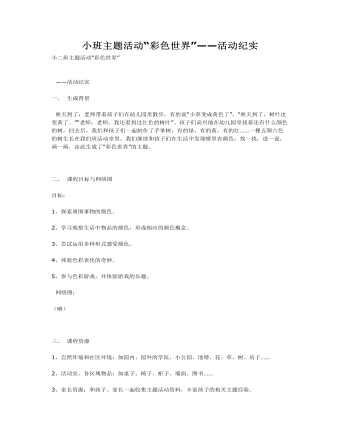
小班主题活动“彩色世界”——活动纪实课件教案
一、 生成背景 秋天到了,老师带着孩子们在幼儿园里散步,有的说“小草变成黄色了”,“秋天到了,树叶也变黄了。”“老师,老师。我还看到过红色的树叶”。孩子们高兴地在幼儿园里找着还有什么颜色的树,回去后,我们和孩子们一起制作了手掌树,有的绿,有的黄,有的红……一棵五颜六色的树生长在我们班活动室里。我们继续和孩子们在生活中发现哪里有颜色,找一找,说一说,画一画,由此生成了“彩色世界”的主题。 二、 课程目标与网络图 目标: 1、探索周围事物的颜色。 2、学习观察生活中物品的颜色,形成相应的颜色概念。 3、尝试运用多种形式感受颜色。 4、体验色彩表化的奇妙。 5、参与色彩游戏,并体验游戏的乐趣。
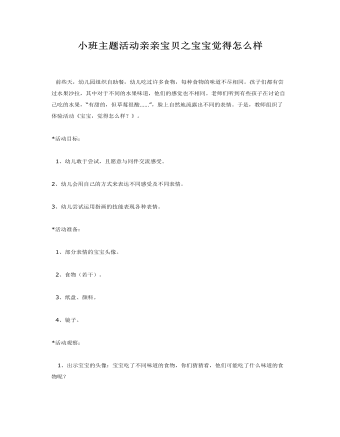
小班主题活动亲亲宝贝之宝宝觉得怎么样课件教案
活动目标: 1、幼儿敢于尝试,且愿意与同伴交流感受。2、幼儿会用自己的方式来表达不同感受及不同表情。3、幼儿尝试运用指画的技能表现各种表情。*活动准备: 1、部分表情的宝宝头像。 2、食物(若干)。 3、纸盘、颜料。 4、镜子。

新人教版高中英语选修2Unit 1 Science and Scientists-Discovering useful structures教学设计
The grammatical structure of this unit is predicative clause. Like object clause and subject clause, predicative clause is one of Nominal Clauses. The leading words of predicative clauses are that, what, how, what, where, as if, because, etc.The design of teaching activities aims to guide students to perceive the structural features of predicative clauses and think about their ideographic functions. Beyond that, students should be guided to use this grammar in the context apporpriately and flexibly.1. Enable the Ss to master the usage of the predicative clauses in this unit.2. Enable the Ss to use the predicative patterns flexibly.3. Train the Ss to apply some skills by doing the relevant exercises.1.Guide students to perceive the structural features of predicative clauses and think about their ideographic functions.2.Strengthen students' ability of using predicative clauses in context, but also cultivate their ability of text analysis and logical reasoning competence.Step1: Underline all the examples in the reading passage, where noun clauses are used as the predicative. Then state their meaning and functions.1) One theory was that bad air caused the disease.2) Another theory was that cholera was caused by an infection from germs in food or water.3) The truth was that the water from the Broad Street had been infected by waste.Sum up the rules of grammar:1. 以上黑体部分在句中作表语。2. 句1、2、3中的that在从句中不作成分,只起连接作用。 Step2: Review the basic components of predicative clauses1.Definition

新人教版高中英语选修2Unit 1 Science and Scientists-Learning about Language教学设计
Step 7: complete the discourse according to the grammar rules.Cholera used to be one of the most 1.__________ (fear) diseases in the world. In the early 19th century, _2_________ an outbreak of cholera hit Europe, millions of people died. But neither its cause, 3__________ its cure was understood. A British doctor, John Snow, wanted to solve the problem and he knew that cholera would not be controlled _4_________ its cause was found. In general, there were two contradictory theories 5 __________ explained how cholera spread. The first suggested that bad air caused the disease. The second was that cholera was caused by an _6_________(infect) from germs in food or water. John Snow thought that the second theory was correct but he needed proof. So when another outbreak of cholera hit London in 1854, he began to investigate. Later, with all the evidence he _7_________ (gather), John Snow was able to announce that the pump water carried cholera germs. Therefore, he had the handle of the pump _8_________ (remove) so that it couldn't be used. Through his intervention,the disease was stopped in its tracks. What is more, John Snow found that some companies sold water from the River Thames that __9__________________ (pollute) by raw waste. The people who drank this water were much more likely _10_________ (get) cholera than those who drank pure or boiled water. Through John Snow's efforts, the _11_________ (threaten) of cholera around the world saw a substantial increase. Keys: 1.feared 2.when 3. nor 4.unless 5.that/which 6.infection 7.had gathered 8.removed 9.was polluted 10.to get 11. threat

新人教版高中英语选修2Unit 1 Science and Scientists-Reading and thinking教学设计
Step 5: After learning the text, discuss with your peers about the following questions:1.John Snow believed Idea 2 was right. How did he finally prove it?2. Do you think John Snow would have solved this problem without the map?3. Cholera is a 19th century disease. What disease do you think is similar to cholera today?SARS and Covid-19 because they are both deadly and fatally infectious, have an unknown cause and need serious public health care to solve them urgently.keys:1. John Snow finally proved his idea because he found an outbreak that was clearly related to cholera, collected information and was able to tie cases outside the area to the polluted water.2. No. The map helped John Snow organize his ideas. He was able to identify those households that had had many deaths and check their water-drinking habits. He identified those houses that had had no deaths and surveyed their drinking habits. The evidence clearly pointed to the polluted water being the cause.3. SARS and Covid-19 because they are both deadly and fatally infectious, have an unknown cause and need serious public health care to solve them urgently.Step 6: Consolidate what you have learned by filling in the blanks:John Snow was a well-known _1___ in London in the _2__ century. He wanted to find the _3_____ of cholera in order to help people ___4_____ it. In 1854 when a cholera __5__ London, he began to gather information. He ___6__ on a map ___7___ all the dead people had lived and he found that many people who had ___8____ (drink) the dirty water from the __9____ died. So he decided that the polluted water ___10____ cholera. He suggested that the ___11__ of all water supplies should be _12______ and new methods of dealing with ____13___ water be found. Finally, “King Cholera” was __14_____.Keys: 1. doctor 2. 19th 3.cause 4.infected with 5.hit 6.marked 7.where 8.drunk 9.pump 10.carried 11.source 12.examined 13.polluted 14.defeatedHomework: Retell the text after class and preview its language points

新人教版高中英语选修2Unit 1 Science and Scientists-Using langauge教学设计
This happens because the dish soap molecules have a strong negative charge, and the milk molecules have a strong positive charge. Like magnets, these molecules are attracted to each other, and so they appear to move around on the plate, taking the food coloring with them, making it look like the colors are quickly moving to escape from the soap.Listening text:? Judy: Oh, I'm so sorry that you were ill and couldn't come with us on our field trip. How are you feeling now? Better?? Bill: Much better, thanks. But how was it?? Judy: Wonderful! I especially liked an area of the museum called Light Games.it was really cool. They had a hall of mirrors where I could see myself reflected thousands of times!? Bill: A hall of mirrors can be a lot of fun. What else did they have?? Judy: Well, they had an experiment where we looked at a blue screen for a while, and then suddenly we could see tiny bright lights moving around on it. You'll never guess what those bright lights were!? Bill: Come on, tell me!? Judy: They were our own blood cells. For some reason, our eyes play tricks on us when we look at a blue screen, and we can see our own blood cells moving around like little lights! But there was another thing I liked better. I stood in front of a white light, and it cast different shadows of me in every color of the rainbow!? Bill: Oh, I wish I had been there. Tell me more!? Judy: Well, they had another area for sound. They had a giant piano keyboard that you could use your feet to play. But then, instead of playing the sounds of a piano, it played the voices of classical singers! Then they had a giant dish, and when you spoke into it, it reflected the sound back and made it louder. You could use it to speak in a whisper to someone 17 meters away.? Bill: It all sounds so cool. I wish I could have gone with you? Judy: I know, but we can go together this weekend. I'd love to go there again!? Bill: That sounds like a great idea!

新人教版高中英语选修2Unit 2 Learning about Language教学设计
The activity theme of this section is to design various activities around the key words in the first text. Therefore, the activities require students to pay attention to the spelling of words. On the other hand, let students grasp the meaning of words more accurately through sentences and short texts. This kind of teaching design also helps to improve the ability of using English thinking.1. Cultivating students' ability to use word formation to induce and memorize vocabulary, and the ability to use lexical chunks to express meaning.2. Guide the students to think independently and use the correct form of words to complete sentences3. Cultivate students' habit of using lexical chunks to express language completely, guide students to draw words in sentences quickly, pay attention to word collocation, so as to accumulate more authentic expressions4. Instruct students to create sentences with the chunks.1. Enable students to use the language points in the real situation or specific contexts flexibly and appropriately.2. Guiding the Ss to use unit topic words and the sentence patterns in a richer context.Step1: Think of a word that best fits each definition.1. to remember sth2.to accept, admit, or recognize sth or the truth/existence of sth3. the process of changing sth or yourself to suit a new situation4 .to make sb feel less worried or unhappy5. a strong desire to achieve sth

新人教版高中英语选修2Unit 2 Reading for writing教学设计
The theme of this section is to express people's views on studying abroad. With the continuous development of Chinese economic construction, especially the general improvement of people's living standards, the number of Chinese students studying abroad at their own expense is on the rise. Many students and parents turn their attention to the world and regard studying abroad as an effective way to improve their quality, broaden their horizons and master the world's advanced scientific knowledge, which is very important for the fever of going abroad. Studying abroad is also an important decision made by a family for their children. Therefore, it is of great social significance to discuss this issue. The theme of this section is the column discussion in the newspaper: the advantages and disadvantages of studying abroad. The discourse is about two parents' contribution letters on this issue. They respectively express their own positions. One thinks that the disadvantages outweigh the advantages, and the other thinks that the advantages outweigh the disadvantages. The two parents' arguments are well founded and logical. It is worth noting that the two authors do not express their views on studying abroad from an individual point of view, but from a national or even global point of view. These two articles have the characteristics of both letters and argumentative essays1.Guide the students to read these two articles, and understand the author's point of view and argument ideas2.Help the students to summarize the structure and writing methods of argumentative writing, and guides students to correctly understand the advantages and disadvantages of studying abroad3.Cultivate students' ability to analyze problems objectively, comprehensively and deeply

新人教版高中英语选修2Unit 2 Reading and thinking教学设计
Her tutor told her to acknowledge __________ other people had said if she cited their ideas, and advised her _______(read) lots of information in order to form __________wise opinion of her own.Now halfway __________ her exchange year, Xie Lei felt much more at home in the UK. She said __________ (engage) in British culture had helped and that she had been__________ (involve) in social activities. She also said while learning about business, she was acting as a cultural messenger __________(build) a bridge between the two countries. keys:Xie Lei, a 19yearold Chinese student, said goodbye to her family and friends in China and boarded (board) a plane for London six months ago in order to get a business qualification. She was ambitious(ambition) to set up a business after graduation. It was the first time that she had left (leave) home.At first, Xie Lei had to adapt to life in a different country. She chose to live with a host family, who can help with her adaptation (adapt) to the new culture. When she missed home, she felt comforted (comfort) to have a second family. Also Xie Lei had to satisfy academic requirements. Her tutor told her to acknowledge what other people had said if she cited their ideas, and advised her to read lots of information in order to form a wise opinion of her own.Now halfway through her exchange year, Xie Lei felt much more at home in the UK. She said engaging (engage) in British culture had helped and that she had been involved (involve) in social activities. She also said while learning about business, she was acting as a cultural messenger building a bridge between the two countries.

新人教版高中英语选修2Unit 2 Using langauge-Listening教学设计
? B: Absolutely! Getting involved with Chinese cultural activities there definitely helped a lot. I got to practice my Chinese on a daily basis, and I could learn how native Chinese speakers spoke.? A: What do you feel is your biggest achievement?? B: Learning Chinese characters! I have learnt about 1,500 so far. When I first started, I didn't think it was even going to be possible to learn so many, but now I find that I can read signs, menus, and even some easy newspaper articles.? A: What are you most keen on?? B: I've really become keen on learning more about the Chinese culture, in particular Chinese calligraphy. As I have learnt Chinese characters, I have developed a great appreciation for their meaning. I want to explore Chinese characters by learning how to write them in a more beautiful way. ? A: Finally, what do you want to say to anyone interested in learning Chinese?? I have really become keen on learning more about the Chinese culture, in particular Chinese Calligraphy. As I have learnt Chinese character, I have developed a great appreciation for their meaning. I want to explore Chinese characters by learning how to write them in a more beautiful way.? A: Finally, what do you want to say to anyone interested in learning Chinese?? B: I'd say, give it a shot! While some aspects may be difficult, it is quite rewarding and you will be happy that you tried.? A: Thanks for your time. ? B:You're welcome.

